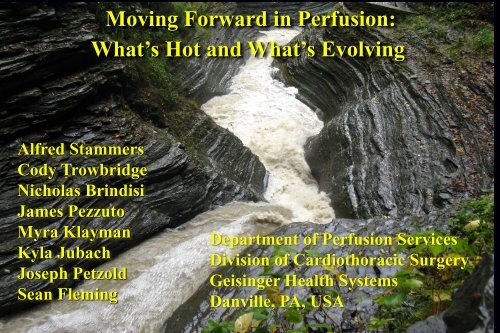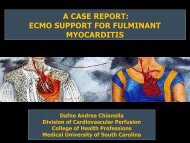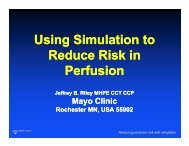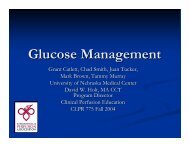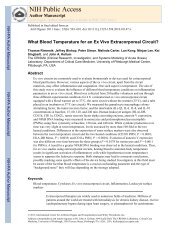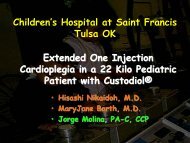PowerPoint Presentation (PDF) - Perfusion.com
PowerPoint Presentation (PDF) - Perfusion.com
PowerPoint Presentation (PDF) - Perfusion.com
Create successful ePaper yourself
Turn your PDF publications into a flip-book with our unique Google optimized e-Paper software.
Moving Forward in <strong>Perfusion</strong>:<br />
What’s Hot and What’s Evolving<br />
Alfred Stammers<br />
Cody Trowbridge<br />
Nicholas Brindisi<br />
James Pezzuto<br />
Myra Klayman<br />
Kyla Jubach<br />
Joseph Petzold<br />
Sean Fleming<br />
Department of <strong>Perfusion</strong> Services<br />
Division of Cardiothoracic Surgery<br />
Geisinger Health Systems<br />
Danville, PA, USA
Disclosure<br />
No financial relationship with any<br />
<strong>com</strong>pany or entity discussed here within.<br />
No product will be used in an off-label<br />
manner.
What’s Hot<br />
What’s Not<br />
<br />
Evidence – ICEBP<br />
‣ Registries<br />
<br />
Educational decline<br />
‣ Program<br />
<br />
Blood Management<br />
‣ IBBM<br />
<br />
Fragmentation<br />
‣ Societal migration<br />
‣ STS Guidelines<br />
<br />
Strategic Focus<br />
<br />
Quality and Safety<br />
‣ PEMR<br />
‣ No consensus<br />
‣ Eroding caseload
Characteristics for Inclusion<br />
Provocative<br />
Proof of Concept<br />
Recent<br />
Four Letter Maximum<br />
VADS<br />
TAVI<br />
NIRS
United States Heart Failure Statistics<br />
AHA Heart Disease and Stroke Statistics 2010<br />
‣ 5.8 Million Patients with heart failure<br />
‣ 550,000 patients diagnosed each year<br />
‣ 15 million office visits 6.5 million hospital days<br />
‣ Annual # of hospitalizations<br />
> 1 million as 1 o diagnosis > 3 million 1 o or 1 o<br />
‣ Rehospitalization rates<br />
> 25% within 1 month > 50% within 6 months<br />
‣ Total US costs for heart failure 2010 – 39.2 billion
Ventricular Assist Devices
HeartMate II Destination Therapy Trial<br />
HeartMate XVE vs. HeartMate II<br />
• Prospective, randomized, multicenter study<br />
Inclusion Criteria<br />
• LVEF < 25%<br />
• Peak VO2 < 14 mL/kg/min (or 50% age and sex predicted)<br />
and either<br />
• NYHA class IIIb-IV symptoms for at least 45 of the prior 60<br />
days on maximally tolerated oral heart failure medications, or<br />
• Dependence on IV inotropes for at least 14 days, or<br />
• Dependence on an IABP for at least 7 days<br />
• Not a candidate for transplantation<br />
Exclusion Criteria<br />
• Irreversible renal, pulmonary, hepatic dysfunction<br />
• Active Infection
Duration of Support (yrs) Median Longest<br />
CF LVAD 1.7 3.7<br />
PF LVAD 0.6 2.1
FDA Approval of CF DT<br />
1. Increase in number<br />
of centers providing<br />
care to patients in<br />
end-stage heart<br />
failure.<br />
1. Expansion in<br />
utilization of VADs<br />
at non-transplant<br />
centers.
Trans Aortic Valve Implantation (TAVI)<br />
1. 50,000 AVR in US per year<br />
2. AVR increase life expectancy over 4-fold<br />
3. AVR <strong>com</strong>plications: 4-18% risk of mortality<br />
4. Increasing population will increase AVR<br />
Edwards Sapien THV<br />
Medtronic CoreValve
Transcatheter Valve Implantation (TAVI)<br />
Risk Benefit Analysis Assumptions<br />
Transcatheter valves will be more effective, but have<br />
more risks, than medical therapy<br />
Transcatheter valves might be less effective, but less<br />
risky, than surgery<br />
?????<br />
Transcatheter valves will be more effective than<br />
medical therapy and less risky than surgery<br />
Julie Swain, MD<br />
Division of Cardiovascular Devices, FDA<br />
STS Transcatheter Valve Symposium
TAVI<br />
Access<br />
Transfemoral<br />
Transapical<br />
Trans-Subclavian or Trans-Carotid<br />
Intervention Location<br />
Off-site – catheterization laboratory<br />
Hybrid OR – endovascular room
TAVI<br />
Complications<br />
Valvuloplasty<br />
Valve Implantation<br />
Aortic instrumentation<br />
1. Ascending aorta dissection<br />
2. Embolic debris liberation<br />
3. Valve embolization<br />
4. Coronary artery obstruction<br />
5. Mitral valve interference<br />
6. LV rupture or hemorrhage<br />
7. Vascular access injury<br />
8. Post-implant instability<br />
9. Distal/Proximal dislocation<br />
of prosthesis
TAVI<br />
Patient Management<br />
Anesthesia<br />
General anesthesia with ET intubation<br />
Heparinization with ACTs > 250 s<br />
Clopidogrel 300 mg<br />
Rapid ventricular pacing<br />
Vasopressors to maintain MAP
TAVI<br />
Patient Management<br />
<strong>Perfusion</strong><br />
Emergent CPB Plan (planning and drills)<br />
Pump in-room with dedicated perfusionist<br />
Intraoperative Autotransfusion (cell salvage)<br />
Rapid deployment precautions<br />
Considerations<br />
Hybrid room (C-arm and table movement)<br />
Extra-personnel – non-cardiac surgical team??<br />
NIRS monitoring
TAVI<br />
<strong>Perfusion</strong><br />
Conventional <strong>Perfusion</strong> CPB<br />
1. Ascending 1. CPS aorta vs. Conventional dissection CPS-MMLSS-MECC<br />
CPB<br />
2. LV rupture central or hemorrhage vs. percutaneous 1. Post-implant cannulation instability<br />
3. Coronary 2. Carotid artery or obstruction Subclavian 2. Valve – bifurcated embolization graft<br />
4. Mitral 3. Mini-ECMO<br />
valve interference<br />
4. TandemHeart
CPS-MMLSP-MECC<br />
Benefits<br />
1. Portability and thumbprint<br />
2. Rapid deployment<br />
3. Self-contained - ECMO<br />
Detriments<br />
1. Flexibility - cardioplegia<br />
2. Limited aspiration<br />
3. Absent PEMR interface
Conventional CPB<br />
Benefits<br />
1. Familiarity - <strong>com</strong>plete<br />
2. Intact safety systems<br />
3. Cardioplegia<br />
Detriments<br />
1. Limited flexibility<br />
2. Incapable of ECMO<br />
3. Location of procedure
Intraoperative Neuromonitoring<br />
NIRS<br />
Non-invasive technique used to monitor regional<br />
oxygenation in cerebral or somatic tissue, measuring<br />
oxygen saturation of hemoglobin in venous capillaries.<br />
Utility<br />
Although assessment is at specific site, variation in<br />
saturation has been shown to act as surrogate marker to<br />
end-organ, or global, perfusion.
CasMed ® Fore-Sight ®<br />
Covidien INVOS
NIRS<br />
Intervention Guidelines<br />
1. Head positioning for cannula placement and/or<br />
decreasing CVP during CPB<br />
2. Depth of anesthesia (CMRO 2 , SMRO 2 )<br />
3. Increase PaO 2 through FiO 2<br />
4. Increase perfusion pressure (CPB MAP)<br />
5. Increased perfusion (CO or Q b Pump)<br />
6. Acid-Base manipulation (hypercarbia)<br />
7. Increased red blood cell volume<br />
hemoconcentration vs. transfusion
NIRS<br />
Critical Values or Threshold<br />
IFU: Greater than 20% from resting baseline or<br />
nadir of 40%<br />
Casati:<br />
Murkin:<br />
Maintain ScTO 2 greater than 75% of resting<br />
baseline<br />
Maintain rSO 2 greater than 75% of resting<br />
baseline.<br />
Derived parameters:
Cerebral<br />
Hepatic<br />
Renal<br />
Muscular
Summary Opportunities for <strong>Perfusion</strong>ists<br />
The efficacy of continuous flow VADs for<br />
destination therapy will expand the role of<br />
perfusionists.<br />
Transcatheter valve implantation techniques<br />
will present perfusionists with new challenges<br />
and opportunities.<br />
Neuromonitoring with NIRS will provide<br />
perfusionists with a modality for measurement<br />
and statistical analysis to improve out<strong>com</strong>es.


